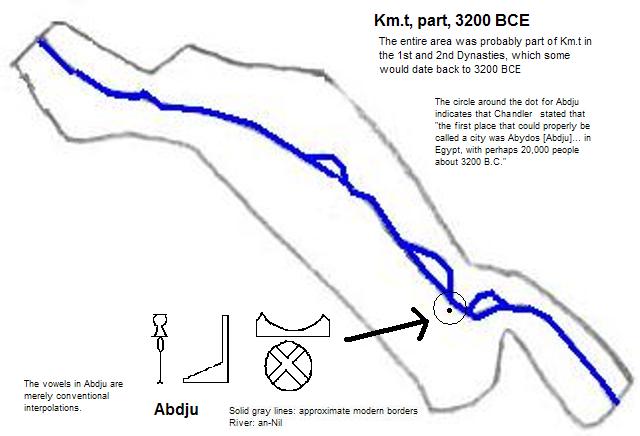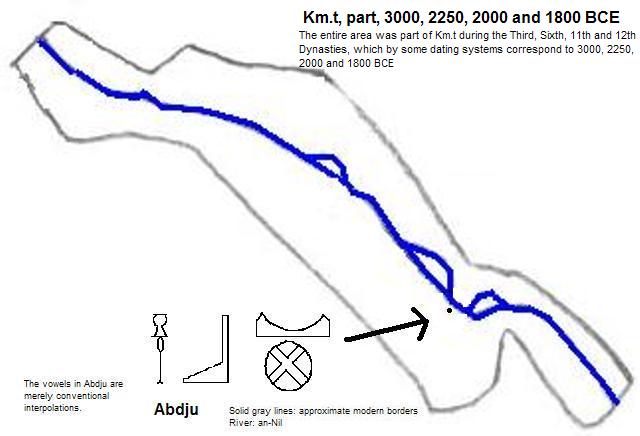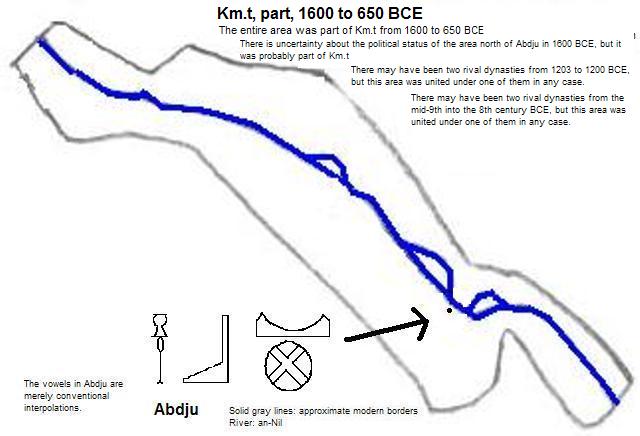ʒbḏw (Abdju)
ʒbḏw (Abdju1 or, in English, Abydos) was originally primarily a funerary site for the city of Thinis,2 later a substantial city in itself. It is located on the left bank of the an-Nil (Nile) in what is today the Sawhāj nome of مصر (Miṣr or Egypt). Chandler lists it as the world's first real city,3 but he may be conflating it and Thinis. The name means Hill of the Reliquary, referring to the religious belief that the god, Wsỉr (Wesir or Osiris), was buried here. Among the ruins are: the King Kha sekhemwy, a walled enclosure, now called the Kom es-Sultan, at the location of the original town and of the Temple for Wsỉr (Early Dynastic); and the temples of Setekhy (Sety) I and Ri'mīsisu (Ramesses) II (New Kingdom). The settlement was occupied from predynastic times up until the 30th Dynasty (fourth century BCE).
| Year | Population | Political entity |
| 3200 BCE4 | 20,0003| Km.t (Kemet or Egypt) | |
External references
Ruins of the Temple for Osiris
Historical maps




Footnotes
1. The vowels are conventional among Egyptologists but are not intended to represent the vowel sounds of the times. The initial 'A' was chosen merely because the character represented as ʒ was the first letter in the Egyptian alphabet.
2. Josef W. Wegner, "Abydos" in Donald B. Redford, ed., The Oxford Encyclopedia of Ancient Egypt, Vol. I (Oxford Unversity Press, 2001).
3. "The Title of Largest City, 3100 B.C.-Now", in Tertius Chandler, Four Thousand Years of Urban Growth, 2nd ed. (The Edwin Mellen Press, 1987).
4. Chandler, op. cit., says it was a capital, which implies it was pre-ỉnbw-hḏ (pre-Memphis). While some sources make ỉnbw-hḏ the capital from the First Dynasty, this change is more commonly said to have occured in the Third Dynasty. Chandler's claim that it was the primary (or only) city of its time implies he means that the capital he referred to was Dynastic, since in pre-Dynastic times three cities rivaled for top rank (Bill Manley, The Penguin Historical Atlas of Ancient Egypt (the Penguin Group, 1996)). So that puts his intent for its population status in the First or Second Dynasty. Dating for the those dynasties is controversial. Estimates for the First range from 3400 BCE (Breasted, Bernal) to 2955 (Helck)--see Chronological Chart I in Martin Bernal, Black Athena, Volume II (Rutgers University Press, 1991).




